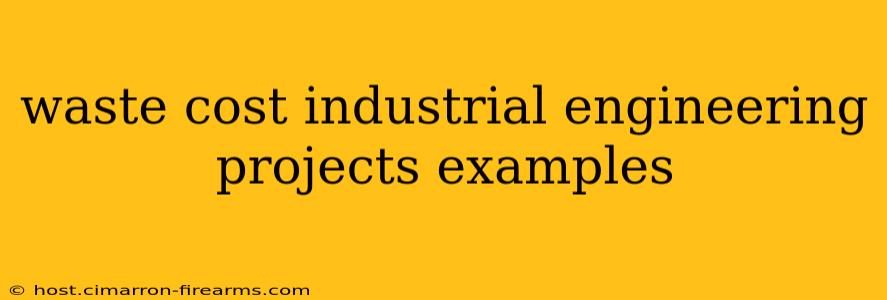Waste, in the context of industrial engineering projects, represents anything that consumes resources without adding value. Identifying and eliminating these sources of waste is crucial for project success, improving profitability, and enhancing competitiveness. This post will delve into specific examples of waste in industrial engineering projects, categorizing them according to the commonly used LEAN principles, and offer strategies for mitigation.
Types of Waste in Industrial Engineering Projects and Examples
Lean principles categorize waste into several key areas. Let's examine how these manifest in industrial engineering projects:
1. Transportation Waste
This refers to unnecessary movement of materials, information, or people. Examples in industrial engineering projects include:
- Inefficient material handling: Poorly designed layouts leading to excessive travel distances for workers and materials during production. For example, a factory layout might require workers to walk long distances between workstations to collect parts or move finished goods.
- Redundant data transfer: Multiple departments handling the same data, leading to delays and errors. This could involve a project team receiving the same information repeatedly through different channels.
- Unnecessary travel for meetings: Teams scheduling in-person meetings when video conferencing would suffice.
2. Inventory Waste
Excess inventory ties up capital, increases storage costs, and risks obsolescence. In industrial engineering projects:
- Overstocking of raw materials: Purchasing excessive quantities of materials due to inaccurate demand forecasting, resulting in storage fees and potential spoilage.
- Work-in-progress (WIP) buildup: Bottlenecks in the production process leading to a large accumulation of unfinished goods, occupying space and increasing the risk of defects.
- Obsolete equipment or parts: Holding onto outdated machinery or spare parts that are no longer needed, tying up valuable resources.
3. Motion Waste
Unnecessary movements by workers lead to fatigue, reduced efficiency, and increased error rates.
- Poor workstation design: Tools and materials are not within easy reach, forcing workers to stretch or reach excessively.
- Inefficient processes: Workers repeatedly performing unnecessary actions due to poorly designed processes.
- Poorly organized workspace: Cluttered work areas impede movement and productivity.
4. Waiting Waste
Delays in the production process can occur due to various factors:
- Machine downtime: Equipment malfunctions or insufficient maintenance leading to production delays.
- Material shortages: Lack of necessary components delaying production runs.
- Bottlenecks: A single slow step in the process holding up the entire line.
5. Overproduction Waste
Producing more than is needed or before it's needed leads to excess inventory, increased storage costs, and potential obsolescence.
- Unnecessary production runs: Producing more than is demanded by the market, leading to wasted resources.
- Producing items too early: Manufacturing products before they are needed, tying up capital and increasing storage costs.
6. Over-Processing Waste
Performing more work than necessary to achieve the desired outcome.
- Unnecessary steps in a process: Performing multiple steps when fewer would suffice.
- Using more sophisticated equipment than needed: Employing advanced technology when simpler tools would be adequate.
7. Defects Waste
Faulty products or services lead to rework, scrap, and customer dissatisfaction.
- Poor quality control: Lack of proper inspection procedures leading to defects that need to be corrected or scrapped.
- Inefficient training: Inadequate worker training resulting in errors and defects.
Mitigation Strategies
Reducing waste requires a systematic approach:
- Value Stream Mapping: Visualizing the entire production process to identify areas of waste.
- Kaizen Events: Short, focused improvement projects targeting specific areas of waste.
- 5S Methodology: Organizing the workspace to improve efficiency and reduce waste.
- Lean Six Sigma: Combining Lean principles with Six Sigma methodology to reduce waste and improve quality.
- Process Improvement Techniques: Implementing techniques like Value Engineering and Design for Six Sigma to minimize waste during the design and development phases.
By carefully analyzing project processes, industrial engineers can pinpoint specific instances of waste, implement appropriate mitigation strategies, and significantly enhance project efficiency, cost-effectiveness, and overall success. Understanding these examples and applying the outlined strategies is crucial for any industrial engineering project aiming for optimization and sustainable profitability.

